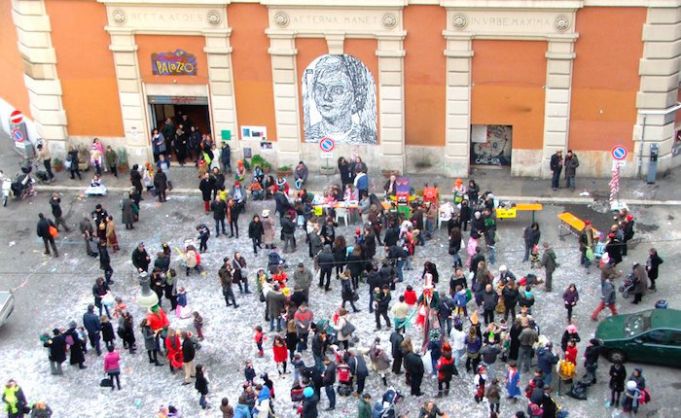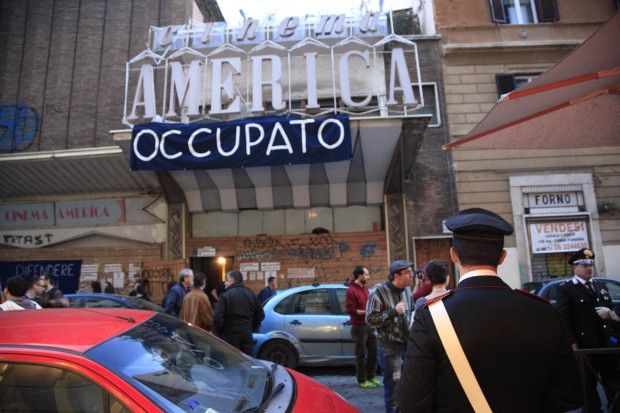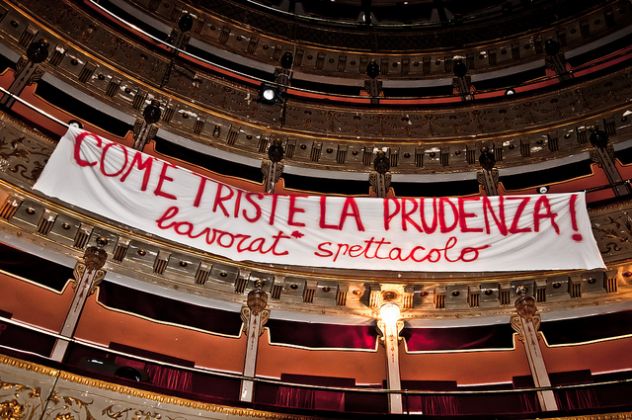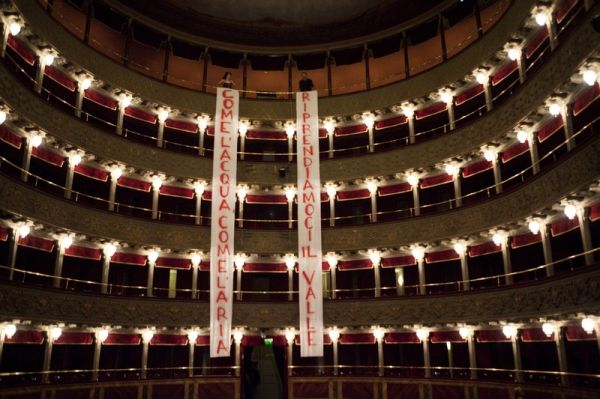Courts sometimes rule in favour of occupation of cultural venues in Rome.
Sarah Barchus
Tourist itineraries are packed with Rome’s famous historic sites, but they tend to ignore the places where history is currently in the making. While visitors are marvelling at monuments, Rome’s residents are otherwise occupied. Grappling with the economic recession and culture-crippling speculation projects, some are mobilising - by staying put. People are repossessing abandoned buildings, repurposing them into centres for cultural and communal growth, political discourse, and the celebration of the arts. These centri sociali are places where squatters are standing up to change their city. Centri sociali go back to the 1980s, some even earlier, and were a result of political rather than economic protest. They have a long tradition of political protest, such as the “occupation” of the secondary schools every autumn.
According to the Rome city council there were around 2,850 occupied buildings in Rome in 2012. This is a surprisingly large number, considering that occupying a space, essentially taking possession of an area or a building without any formal permission, is illegal.
Those living or operating in occupied spaces do so with the constant threat of eviction. However, history has proven the centri sociali to be fertile grounds for change, not only in Rome but also in Milan, where Leoncavallo has been building a community around various occupied spaces since 1975. And sometimes the law even takes the occupiers’ side.
One such example is the Nuovo Cinema Palazzo in Rome’s S. Lorenzo district. In 2011, when local residents learned that the cinema was to be transformed into a casino, they staged what was supposed to be a three-day symbolic protest, which has become an almost three-year occupation. Unhappy with the turn of events, the developers took the matter to court. Defending their actions the occupiers proved that their use of the space, though technically in violation of the law, was in the best interest of the community. The court ruled in their favour, allowing them to continue occupying the cinema.
“This was very important because it created a precedent,” explained Emma Gainsforth, a Roman of American/English heritage, and a participant in the occupation. Not only was the court case a first, but the Nuovo Cinema Palazzo movement is also in itself unique.
Gainsforth explained that people of the community have always used the ex-cinema as a space to bring their concerns and problems to the table. After the occupation, that “table” became a little more organised. Tired of inefficiencies and inaction, the neighbourhood drafted a community constitution, and formed “La Libera Repubblica di S. Lorenzo”.
“It was kind of a joke, but we were completely serious about it,” Gainsforth said. Organising its initiatives into “tables” – speculation/rent, culture, economy – the ex-cinema invited all, artists, students, lawyers and even some highprofile politicians, to share its ideas on how to fix the problems plaguing the community. “Slowly, slowly things are working out,” Gainsforth said. “Eventually we’ll have our own proposal – we’d like to reach a definition.”
Other centres like the 18th-century Teatro Valle Occupato use the arts to inspire change and add to the social wealth of the neighbourhood. Actors and artists initiated the occupation in June 2011 in reaction to a plan to privatise the oldest theatre in Rome. Last September, their efforts were rewarded when the theatre officially became a foundation, legitimising the movement.
The occupation garnered international support from numerous institutions including the Royal Court in London, Schaubühne Berlin, the French Academy of Villa Medici and the Swiss Institute of Culture in Rome, and the Union of the Theatres of Europe. Individuals also demonstrated their approval, such as American director Francis Ford Coppola and British director Peter Brook, who attended the theatre’s screening of his film The Tightrope last spring.
Teatro Valle Occupato also hosts public discussions with intellectuals, professors and residents to inform and unite the community around the issues that affect them. Placing a heavy focus on selfgovernance, the theatre has worked with lawyers Ugo Mattei and Stefano Rodotà to restore people’s rights and to protect the common good. Like Nuovo Cinema Palazzo, the movement stresses the “idea of law” over the “rule of law” to restore governance to its original purpose: to promote and protect the people’s wellbeing.
In 2010, after 35 years of screening films, the former Grauco film club in Pigneto closed its doors due to lack of funds. However, the determination of four individuals inspired a group of 60 volunteers to refurbish the club, and a year later it reopened as Cinema Kino. It now shows international and Italian films and hosts exhibitions, book presentations and concerts.
In another take-charge movement, Cinema America Occupato in Trastevere was occupied in 2012. Though the cinema continues to screen films, its typically young occupiers are not content to sit back and watch when it comes to maintaining and changing their community. “Nobody would expect us to keep this place so clean and tidy, and to be able to self-govern it. We are young, but responsible. It is politics that does not want us to grow up,” 20-year-old occupier Matteo told an Al Jazeera journalist.
Occupied space Angelo Mai is a meeting point for “artists fighting for the right to housing and independent spaces for art and culture.” Born in an abandoned boarding house occupied by 25 families in 2004, the movement had to leave in 2006 and was without a physical home for three years. During that time, the group formed the mobile orchestra “Collective Angelo Mai” and “Bluemotion”, a performance group of actors and musicians. Angelo Mai found a new home at Viale delle Terme di Caracalla and opened Angelo Mai Altrove Occupato, what looks like a giant warehouse with a stage for music, theatre and workshops.
The occupied movements, whether they are repossessing buildings for the arts or to provide basic community needs, belong to a long Italian tradition that goes back to the student revolts of the 1960s. A number of Rome’s centri sociali such as Brancaleone and Forte Prenestino gained such recognition for their music scene in the 1990s that they became mainstream, proving that sometimes a mixture of community resilience and cultural activity can win out against all the odds.
Side notes:
▶ Forte Prenestino. The abandoned space at Via Federico Delpino was occupied in 1986. Now as one of the largest occupied spaces in Rome, it hosts film screenings, workshops, festivals and courses.
▶ Brancaleone. In 1990 occupiers took over the building on Via Levanna which had been abandoned for 10 years. Now one of Rome’s most famous centri sociali, Brancaleone is a go-to scene for electronic music as well as reggae, rock, indie and punk.
▶ Angelo Mai Altrove Occupato. In 2004, the need for housing incited the movement. After occupying several spaces, the movement evolved into a cultural collaboration. Now located at Viale delle Terme di Caracalla, it hosts musical and theatrical performances as well as artistic and intellectual workshops.
▶ Cinema Kino. Formerly the Grauco film club, the old cinema in Pigneto was occupied in 2010 and transformed into Cinema Kino which shows Italian and international films.
▶ Nuovo Cinema Palazzo. The residents of S. Lorenzo occupied the cinema in 2011 to prevent it from being transformed into a casino. Now the old cinema acts as a social gathering space where people face community issues together and host cultural events.
▶ Teatro Valle Occupato. Actors and artists occupied the 18th century theatre in 2011 to protest a plan to privatise the space. The occupation led to the formation of a legitimate foundation in September and now continues to function as a theatre, as well as hosting lectures and discussions.
▶ Cinema America Occupato. The cinema in Trastevere was going to be torn down and replaced by apartments until locals occupied the space in November 2012. Now the cinema continues to screen films.
This article was published in the March 2014 edition of Wanted in Rome magazine.






















